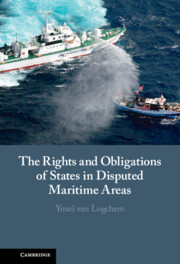Book contents
- The Rights and Obligations of States in Disputed Maritime Areas
- The Rights and Obligations of States in Disputed Maritime Areas
- Copyright page
- Contents
- Preface and Acknowledgements
- Cases
- Treaties and Legislation
- Abbreviations
- 1 Introduction
- 2 Disputed Maritime Areas: Setting the Scene
- 3 Disputed Maritime Areas: General Rules of International Law
- 4 Disputed Territorial Sea and Contiguous Zone Areas: Applicable Conventional Rules
- 5 Disputed EEZ and Continental Shelf Areas: Applicable Conventional Rules
- 6 Case Law Involving the Rights and Obligations of States in Disputed Maritime Areas
- 7 Disputed Waters Generated by Claims Made from Disputed Land Territory: What Are the Rights and Obligations of States?
- 8 Acts of Unilateralism in Disputed Maritime Areas: A Survey of State Practice
- 9 Are the Rights and Obligations of States in Disputed Maritime Areas Sufficiently Defined in International Law?
- Index
2 - Disputed Maritime Areas: Setting the Scene
Published online by Cambridge University Press: 01 October 2021
- The Rights and Obligations of States in Disputed Maritime Areas
- The Rights and Obligations of States in Disputed Maritime Areas
- Copyright page
- Contents
- Preface and Acknowledgements
- Cases
- Treaties and Legislation
- Abbreviations
- 1 Introduction
- 2 Disputed Maritime Areas: Setting the Scene
- 3 Disputed Maritime Areas: General Rules of International Law
- 4 Disputed Territorial Sea and Contiguous Zone Areas: Applicable Conventional Rules
- 5 Disputed EEZ and Continental Shelf Areas: Applicable Conventional Rules
- 6 Case Law Involving the Rights and Obligations of States in Disputed Maritime Areas
- 7 Disputed Waters Generated by Claims Made from Disputed Land Territory: What Are the Rights and Obligations of States?
- 8 Acts of Unilateralism in Disputed Maritime Areas: A Survey of State Practice
- 9 Are the Rights and Obligations of States in Disputed Maritime Areas Sufficiently Defined in International Law?
- Index
Summary
In the absence of delimitation, there are competing sets of sovereignty or sovereign rights of two States over the same area, which also imply exclusivity. This lies at the heart of why possible conflicts may occur between States. Different variants of overlapping claims can occur between States: that is, as regards internal waters, territorial seas, contiguous zones, EEZs, (extended) continental shelves and archipelagic waters. Varying with the type of disputed maritime zone involved, specific international law questions arise. Both claimant coastal States and third States can be affected by the existence of disputed maritime areas. For claimant States, questions arise around the extent to which rights can, and obligations have to, be exercised. For third States, or their nationals, questions arise concerning how to exercise rights that may have been obtained from one claimant State, and what obligations they must observe when acting, or seeking to act, in a disputed area. As State practice exemplifies, where a claimant, or a national of a third State, has undertaken unilateral conduct in a disputed maritime area, for example concerning mineral resources or fisheries, which regularly prompts the other claimant into responding – including, by taking law enforcement measures.
Keywords
- Type
- Chapter
- Information
- Publisher: Cambridge University PressPrint publication year: 2021



